Introduction to Digital Strategy
Pierre-Yann Dolbec
Overview
In this chapter, we discuss some key vocabulary associated with digital marketing, covering concepts such as inbound and outbound marketing and paid, owned, and earned media activities. We then turn our attention to the framework we are going to cover for the rest of the semester, the RACE framework. We briefly cover the four stages of the framework before turning out attention to how to link persona, journey, and strategy. We conclude the chapter by understanding how the RACE framework can support competitive analysis.
Learning Objectives
Understand key terms associated with online strategy, the objectives of the four stages of the RACE framework, how it links to personas and journeys, and how to use it to support competitive analysis.
Inbound and Outbound Marketing
Inbound and outbound marketing represent two broad approaches to connecting with consumers. Inbound marketing aims at bringing visitors “in,” drawing them to your company via, typically, content marketing, social media, and well-optimized websites. In this first approach, consumers find you because you represent them.
Outbound marketing is what we typically think of when we think of advertising: the promotion of products or services through advertising and promotions. In this case, a message goes “out” from your company and stops consumers in whatever they were doing (e.g., a consumer is “stopped” by an ad when scrolling on Instagram or reading their Facebook feed; they are stopped by an ad at the start of a YouTube video, or they are stopped by an ad which cuts a newspaper article or a blog post in two).
Inbound marketing is also associated with permission marketing, where advertising is welcomed because permission to be advertised to has already been obtained and advertising is anticipated (e.g., email marketing), and two-way communication, meaning that there can be an interaction between consumers and the brand (e.g., consumers can comment on social media posts and on blog articles). A few further characteristics of inbound marketing are that it is
- sought, meaning that consumers find you,
- one of the fastest-growing strategies for marketing online and has been over the last decade,
- seen as cheaper to perform since companies do not need to invest in ads (although there are costs associated with content creation), and
- aimed at customer acquisition.
Conversely, outbound marketing is associated with interruption marketing, where marketing efforts such as ads interrupt what a consumer is doing, and one-way communication, because consumers cannot talk to ads. Outbound marketing is also
- imposed, because consumers do not agree to be advertised to,
- decreasing in popularity, although this is debated,
- expensive, because there are fees associated with putting ads online, and
- aimed at awareness creation, as has typically been the case with traditional advertising.
Examples of inbound marketing include blog posts, infographics, e-books, whitepapers, social media posts, tutorials, and the like.
Examples of outbound marketing include advertising of any sort, which we are going to cover in more detail in the next chapter.
Paid, Owned, and Earned Media
We differentiate between three types of media online: paid, owned, and earned.
Paid media are media activities you pay for. These media activities are typically performed on a third party channel (i.e., not your own website) that is paid by your company to conduct the activity. Your company controls the content, but the third party controls where this content is shown. Examples include search ads, display ads, paid influencers, paid content promotion, social media ads, product placements, and the like.
Owned media activities are media activities that are hosted on channels that you own, i.e., on your own platforms. They include your web properties (e.g., blog posts on your website) and social media channels.
Earned media activities are media impressions that you earn because your content is shared. Here, consumers (and sometimes professionals) become the channel. Shared social media posts, reviews, and other consumer-generated content such as ratings, social recommendations, content created on wikis, or forum discussions are examples of earned media activities. The coverage of your company by journalists also falls under earned media activities.
Very importantly, although these are conceptually distinct types of media activities, an ideal campaign will integrate them. For example, you can create content on your website and social media channels that you will also push by advertising on social media websites and other websites using banner ads, and you are making these efforts in the hopes that your content will be widely shared by others. This is the typical strategy underlying viral marketing campaigns.
Take, for example, the widely successful ad for Doritos during the 2020 Superbowl. Doritos created an ad that they hosted on their website and social media channels (e.g., YouTube). The ad was pushed as a paid media activity during the Superbowl to the tune of several million dollars. It was also associated with a Tik Tok hashtag campaign, #coolranchdance, which fueled earned media impressions. It is this intersection of paid, owned, and earned media activities that leads to the creation of successful online marketing campaigns!
Objectives, Goals, and KPIs
Objectives, goals, and KPIs are the next set of concepts we will cover. Objectives represent what you want to achieve for your company. Ideally, objectives should be SMART:
- specific
- measurable
- attainable
- realistic
- time-bound
Goals are actions that you want users to take. We use the vocabulary of goals to designate user’s actions since this is typically how goals are positioned in web analytics (e.g., Google Analytics). Distinguishing between objectives (what you want to achieve) and goals (what you want your users to achieve) just makes things clearer.
KPIs—key performance indicators—are metrics used to evaluate the performance of your company based on a particular objective or activity. KPIs typically have targets, specific values that your company is aiming to achieve within a certain time period.
These concepts work together to help you plan campaigns: Objectives can be used to identify goals for users to achieve, which can be measured using KPIs (Figure 4.1).
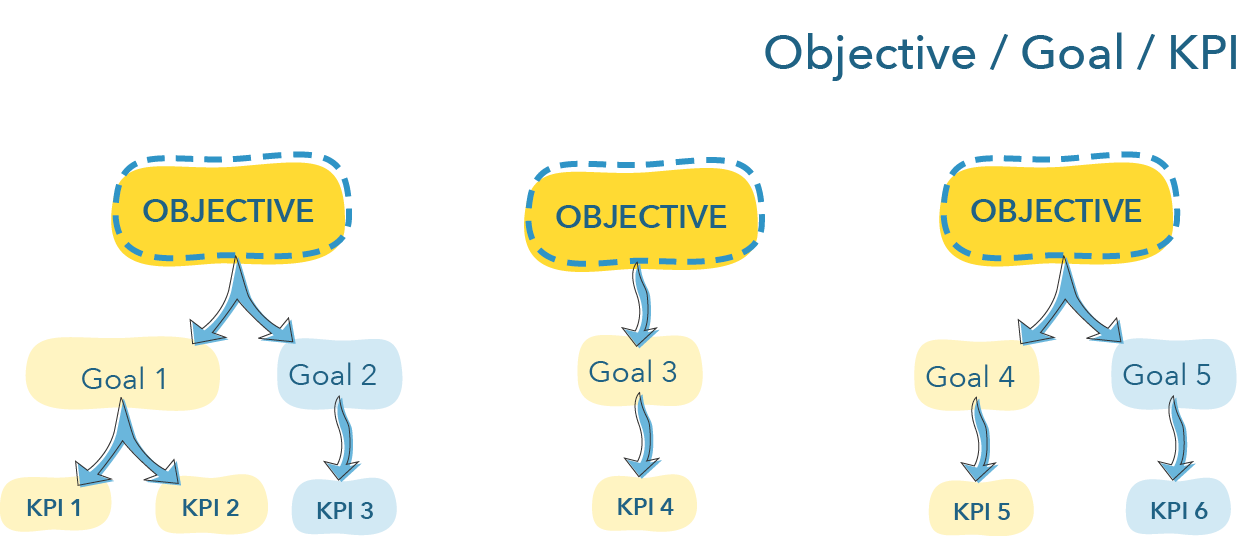
For example, an objective for your company might be to increase product awareness. In order to achieve this objective, you might set up goals for your users, such as subscribing to email updates and engaging in some key features you believe will help raise product awareness. It is then possible to identify KPIs to measure your success for these user goals, such as “number of contact forms submitted” or “use of the key feature of the virtual mirror” (see Figure 4.2 for an example or, for the text version, click here).
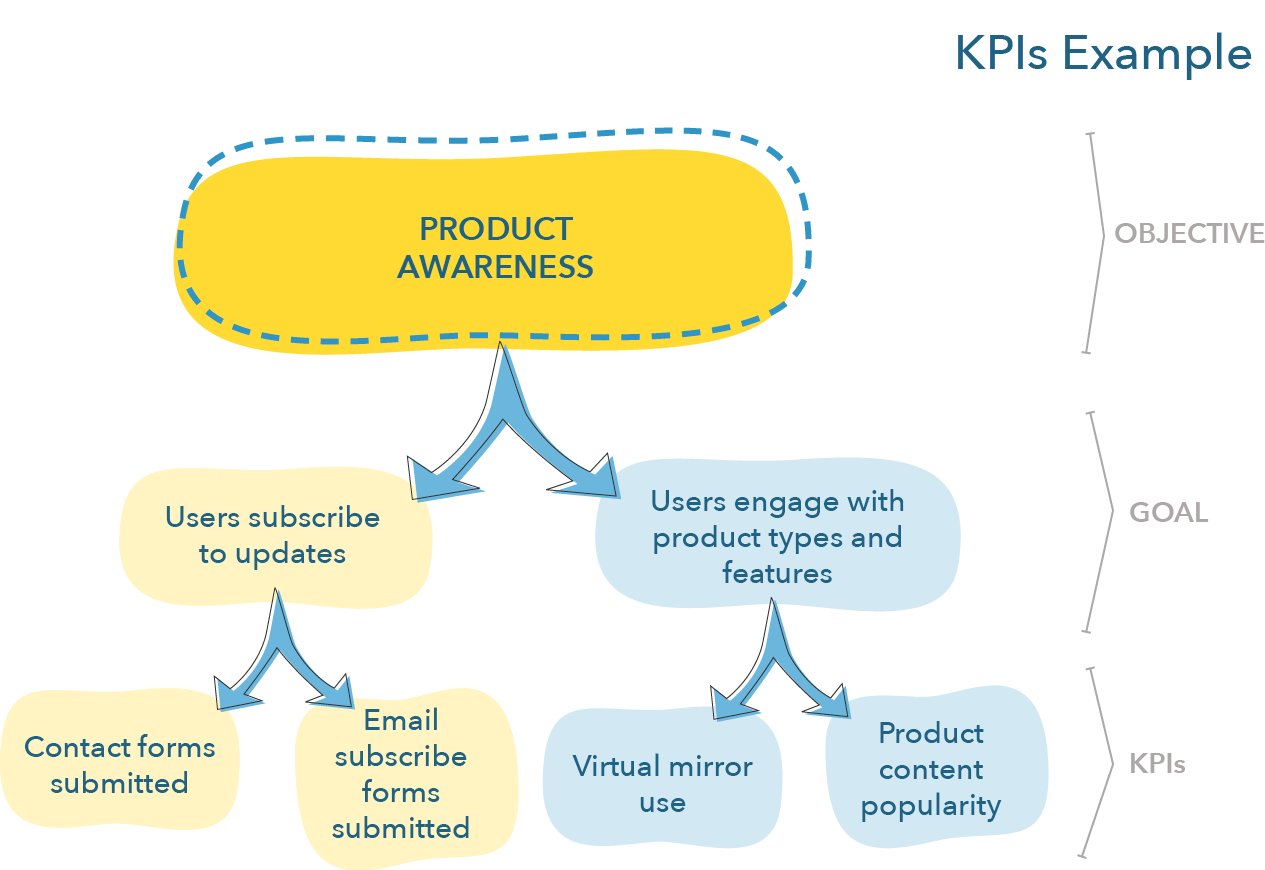
Strategy and Tactics
Strategy and tactics are the last key terms we need to better understand the RACE framework. Strategy represents the path you intend to take to achieve a specific objective. This aligns with Jain’s (1993) understanding of strategy as “the pattern of major objectives, purposes and goals, and essential policies and plans for achieving those goals, stated in such a way as to define what business the company is in or is to be in.”
In this course, we are going to emphasize how, to implement a strategy and achieve specific objectives, a company deploys tactics—tools used to meet objectives. Examples of tools we will discuss include banner advertising campaigns, search ad campaigns, and the use of content marketing on social media.
Let’s combine the vocabulary we just introduced in an example.
Objective
- Increase sales through our eCommerce platform by 10% within the next six months.
Tactics
- Search advertising pay-per-click (PPC) campaign using specific keywords, with a budget, time frame, etc.
- Social media campaign using the Facebook brand page, with marketing material
KPIs per tactic
- Search advertising: clickthrough rate (CTR), bounce rate
- Social media campaign: clickthrough rate, share ratio/amplification rate
Targets per tactic
- Search advertising: CTR of XX%, bounce rate of XX%
- Social media campaign: CTR of XX%, share ratio of XX%
We can now turn our attention to the RACE framework.
RACE Framework
Chaffey’s RACE framework is a conversion-based framework. Conversion marketing is a strategic approach that explicitly aims at increasing customers. The framework we will study here is part of a greater set of strategic approaches, such as HubSpot’s original “attract-convert-close-delight” strategy, which became their “flywheel business model,” or the grandfather of conversion marketing approaches, the “pirate metrics” AARRR model (acquisition-activation-retention-referral-revenue) shown in Figure 4.3 (text version can be found here).
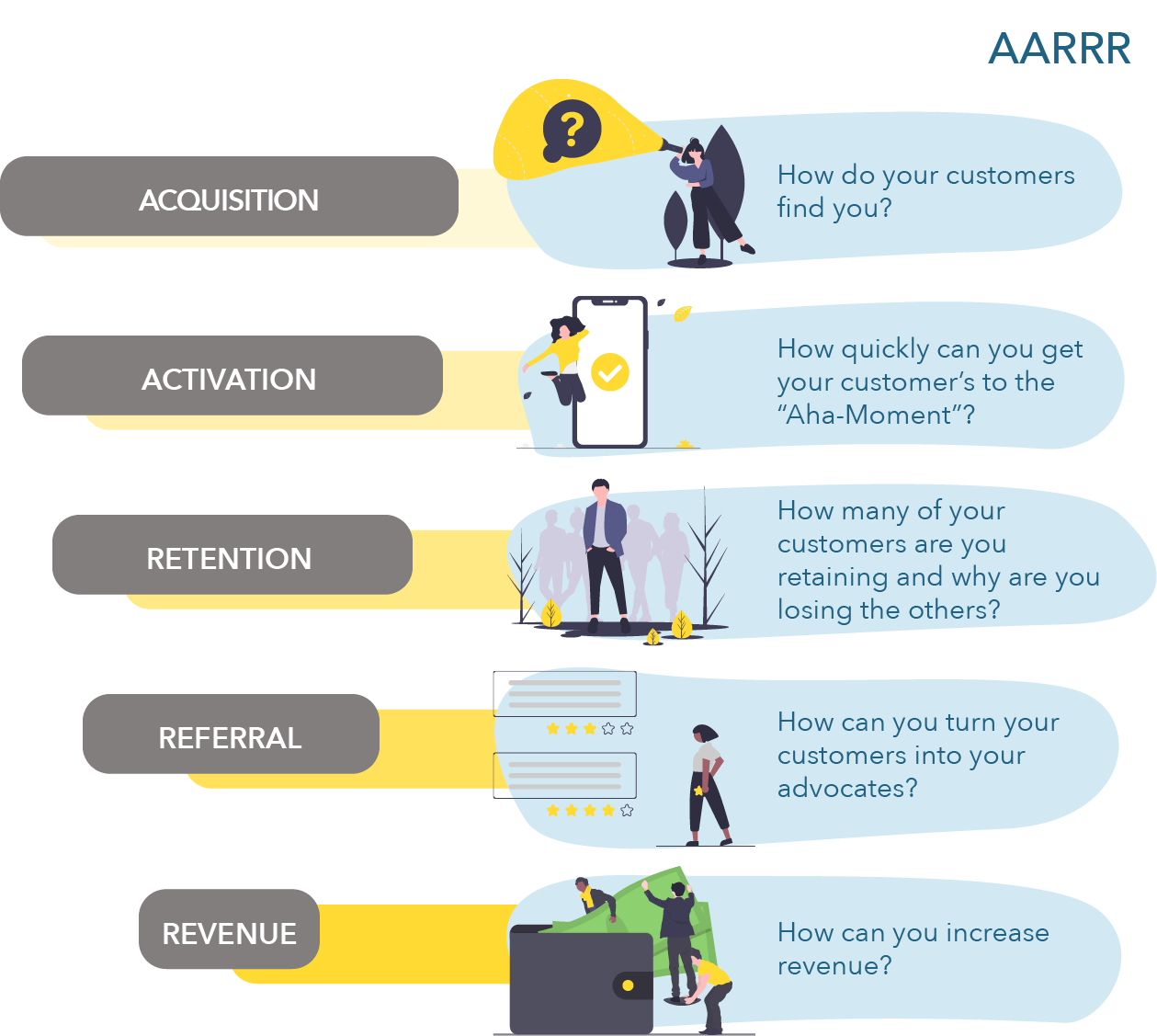
These different frameworks propose stages with different names, but the central idea of this strategic approach is the same. To convert, you need to move people through four stages:
- visitor (people come to your website)
- lead (visitors are converted into a qualified potential customer i.e., somebody who is interested in your product and is also somebody you are interested in selling to)
- customer
- repeat customer
Your goals at each stage are as follows:
- Visitors: In brief, you create campaigns to attract people to your website.
- Leads: Once they are on your website, you want to (1) find ways to see if they are interested in you, (2) find out if you are interested in them, i.e., whether they can be a customer of yours (because not all visitors are people who can buy your product or service), and, if they fit these two categories, and there is a mutual interest, (3) find a way to continue the conversation with them (usually by collecting their email address or making sure they follow you on social media).
- Customers: Once you have identified a mutual interest, you move to accompany people on their journey so that you can convert them from a lead to a customer of yours.
- Repeat customers: After their purchase, you capitalize on their (hopefully) positive experience with your company so that they can co-create on your behalf (e.g., write reviews) and continue their journey as a customer of yours.
The RACE framework presents four stages that help us plan for and coordinate different marketing activities to achieve these objectives.
R stands for REACH
During the Reach stage, your company has two objectives:
- to build awareness about your brand, products, and services through offline and online media activities, and
- to drive traffic using inbound and outbound marketing activities and paid earned and owned media touchpoints.
At this stage, you will mostly concentrate on addressing people’s problems.
A stands for interACT
During the Act stage, your company has two objectives:
- to generate positive interactions on your owned media and
- to create leads, i.e., identify potential customers and make sure they can be your customer (we will call these “qualifying” leads later on in the semester).
At this stage, we are going to emphasize how we should focus on addressing consumers’ problems as well as helping them evaluate their options.
C stands for CONVERT
During the Convert stage, your company has one objective: converting leads into sales.
At this stage, we are going to emphasize how we should focus on talking about why your brand, product, or service is the best option for consumers. We will also touch on how to optimize our owned media order to maximize conversions, a process that is called “conversion rate optimization.”
E stands for ENGAGE
During the Engage stage, your company has two objectives:
- to build customer advocacy and
- to foster repeat visits and sales.
At this stage, the idea is to build long-term engagement by continuously contributing to consumers’ lives by creating value. We also want to identify engaged customers in order to foster their participation and engage them in co-creation activities to participate in our campaigns and support our marketing efforts.
Figure 4.4 presents how these objectives evolve over time with each of the stages (text description here).
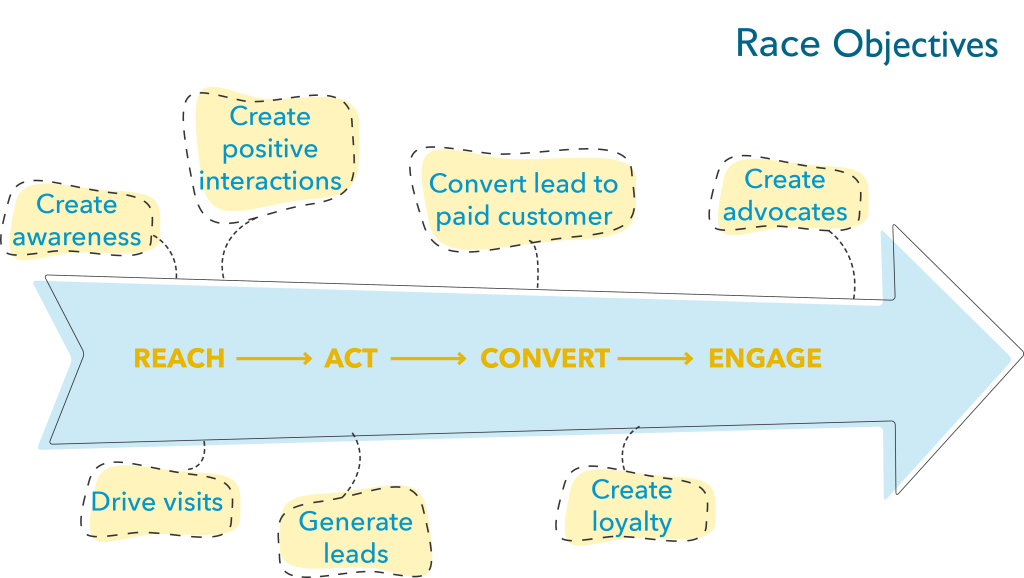
From Persona and Journey to Strategy
As we discussed during the last two chapters, the goals, needs, motivations, and challenges of consumers provide the raw material from which to create content for each persona. Journeys tell you what your content should be about (problem, solutions, and your product), and how it addresses different stages of the journey. See Figure 4.5 for a brief recap of Chapter 3.

Let’s take the example of making content and associated search ads, i.e., creating a blog post and then deciding to advertise this blog post on Google SERPs. As we discussed in previous chapters, your goal when optimizing your webpages is to identify keywords consumers will use to perform searches online. The idea behind making search ads is similar. We covered a few ways to help do so, including
- considering who they are/what they need (persona),
- how they go about solving their needs (journey), and
- what they search in order to do so (journey, ZMOT, types), as well as
- benchmarking against competition.
Once you’ve identified keywords that your consumers are using throughout their journey, you can start creating content or ads based on these keywords so that you show up on a search engine when a consumer does this search.
The concept of a persona helps identify general keywords based on customers’ needs, motivations, challenges. Considering their journey helps identify specific keywords based on how users go about answering needs, motivations, and challenges throughout that journey. Here are two examples:
- If a consumer has pain in their lower back, they might perform a Google search to find out how to address this pain. This presents an opportunity to create awareness around a back pain–related product you are selling (e.g., a pair of sneakers).
- If a consumer wants to compare sneakers to understand which pair offers the best support to address back pain, this provides you with an opportunity to compare your product to those of your competitors.
| Stage of Journey | ||||
|---|---|---|---|---|
| Awareness | Active Evaluation | Purchase | Post-Purchase | |
| Concrete actions | Action: Goes to Google to search for general information about their problem
Search (informational): “How to reduce back pain” |
Action: Goes to Google to compare alternatives
Search (informational): “shoes vs. posture vs. exercise back pain” |
Action: Goes to Google and types the name of the brand and product they want to buy
Search (transactional): “Brand XYZ best price sale” |
Action: Writes product review on retailer’s website |
| Opportunity | Create content to inform and educate consumers about back pain | Create content to inform and educate consumers about back pain solutions | Position your product as the best option for back pain | Leverage engaged consumers to create reviews |
| Tactic | Create a blog post with the keywords “how to,” “reduce,” and “back pain”
Create PPC campaign on associated keywords |
Create several blog posts that compare your product vs. competitors; include relevant keywords (e.g., “best shoes,” “posture,” “back pain”)
Create PPC campaign on associated keywords |
Search ad campaign on keywords (“Brand XYZ shoes,” “best price”) and place an ad to offer a 10% rebate for first-time clients on your website | Give a rebate for a future purchase when writing a review |
From a Journey Map to a Conversion Path
A journey map is a visual representation of the consumer journey. The map transforms a rather abstract way of understanding how consumers purchase products (i.e., awareness, consideration, purchase, and loyalty) to something concrete, with specific actions and touchpoints, that a brand can use to create a marketing strategy.
A conversion path is how a brand is thinking of enacting this strategy. It ties together multiple tactical activities (e.g., search ads and content marketing). It can be defined as a description of the steps that a company wants consumers to take so that they achieve a desired goal. In the digital marketing vocabulary, a conversion occurs when a consumer achieves a goal you wanted them to achieve. The nature of that goal can vary widely: it could be visiting a page, clicking on a link, sending you their email address, buying a product, spending more than a specific amount of time on one of your pages, viewing a certain number of pages during a session, using a key feature—the list goes on. To create a conversion path, companies plan a set of steps that they want consumers to take in order to achieve the designated goal. The shortest conversion path that is typically presented in digital marketing leads from ad to content to landing page (Figure 4.6).
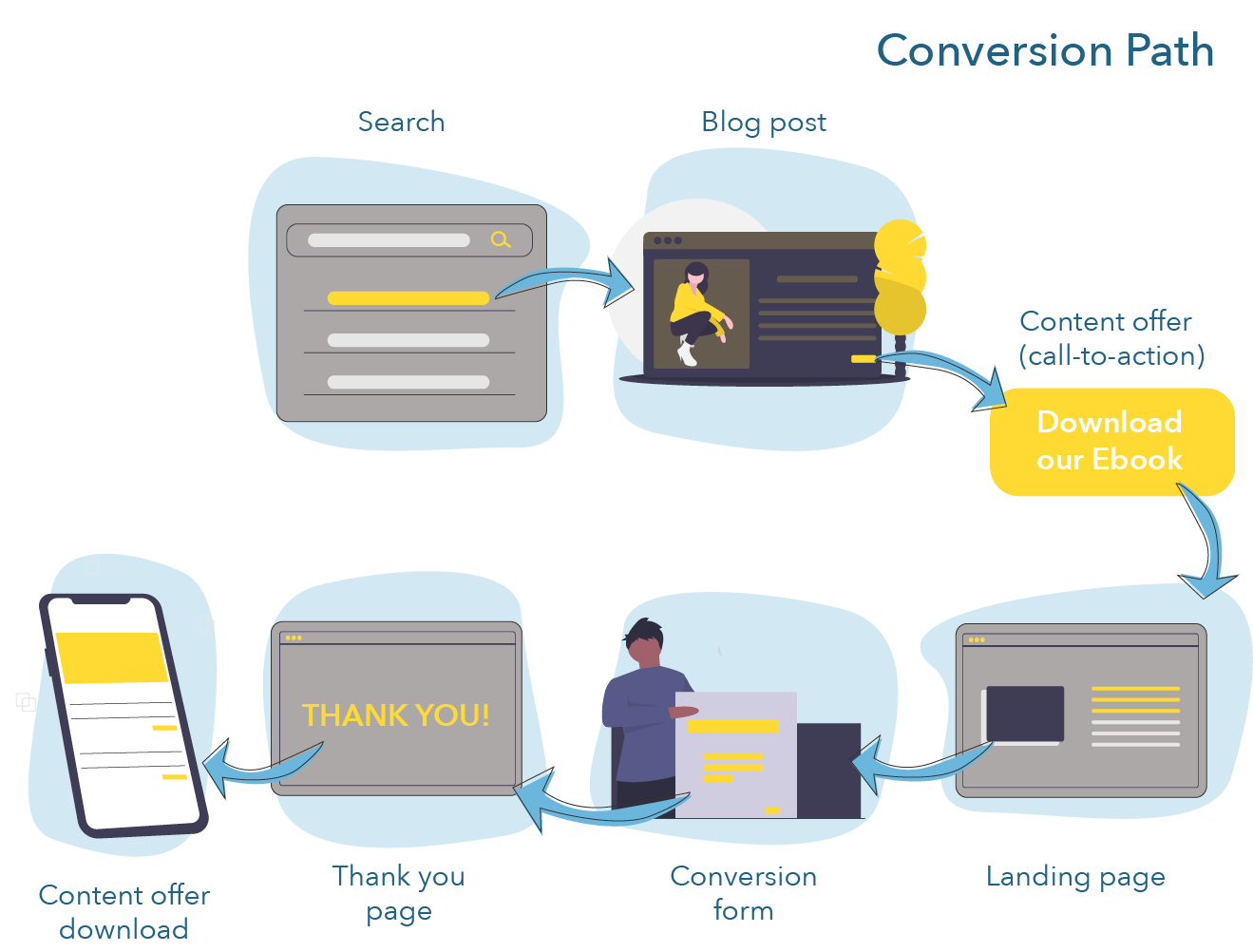
The planning of the steps consumers are going to take to achieve what you want them to achieve is central to create digital marketing campaigns. We do not simply create content and ads in the hopes that consumers are going to visit our website or click on our ads, without any idea of what will happen next. Rather, the best-strategized campaigns always answer the question, What comes next? For example, if you’re creating an ad to appear at the top of a SERP, what comes next? What are you expecting people to do? Where are you leading them? What should they be doing once they get on this page? Why? Answering these questions is how you can create highly converting campaigns because you have a clear idea of the goal consumers should achieve, and you can therefore create pages and ads that will lead them to achieve these goals.
Depending on who you ask, it takes between 5 and 13 touchpoints (or interactions with your brand) to generate a qualified, sales-ready lead (Salesforce 2015; Online Marketing Institute 2013). We will come back to the notion of qualified lead (i.e., a lead that you believe can be your customer) and sales-ready (i.e., a lead that is at the purchase stage) later during the semester. For this chapter, what is important to understand is that, without planning ahead in advance what these 5 to 13 touchpoints will be, it will be quite difficult to create sales. The task of a digital marketer is thus understanding how to bring people through a set of smaller goals, like visiting a blog post, spending 3 minutes reading the post, giving the company an email address, opening the first email (and so on), that will lead them to achieve certain milestones toward making a purchase. Otherwise, a company will be flying in the dark, with no clear strategy as to how to make sales, apart from putting ads online and creating content.
For your term project, your goal is to create a clear conversion path composed of three inbound and three outbound marketing activities. They can be part of the same path (see the example in Figure 4.7) or part of different paths (see Figure 4.8 or text description), but you need to think ahead to a set of tactics and associated marketing activities that are clearly linked to making people “walk” along the path you’ve created for them. Ideally, your path should indicate what you are doing (i.e., your tactic) and what you expect consumers to do (i.e., a goal).
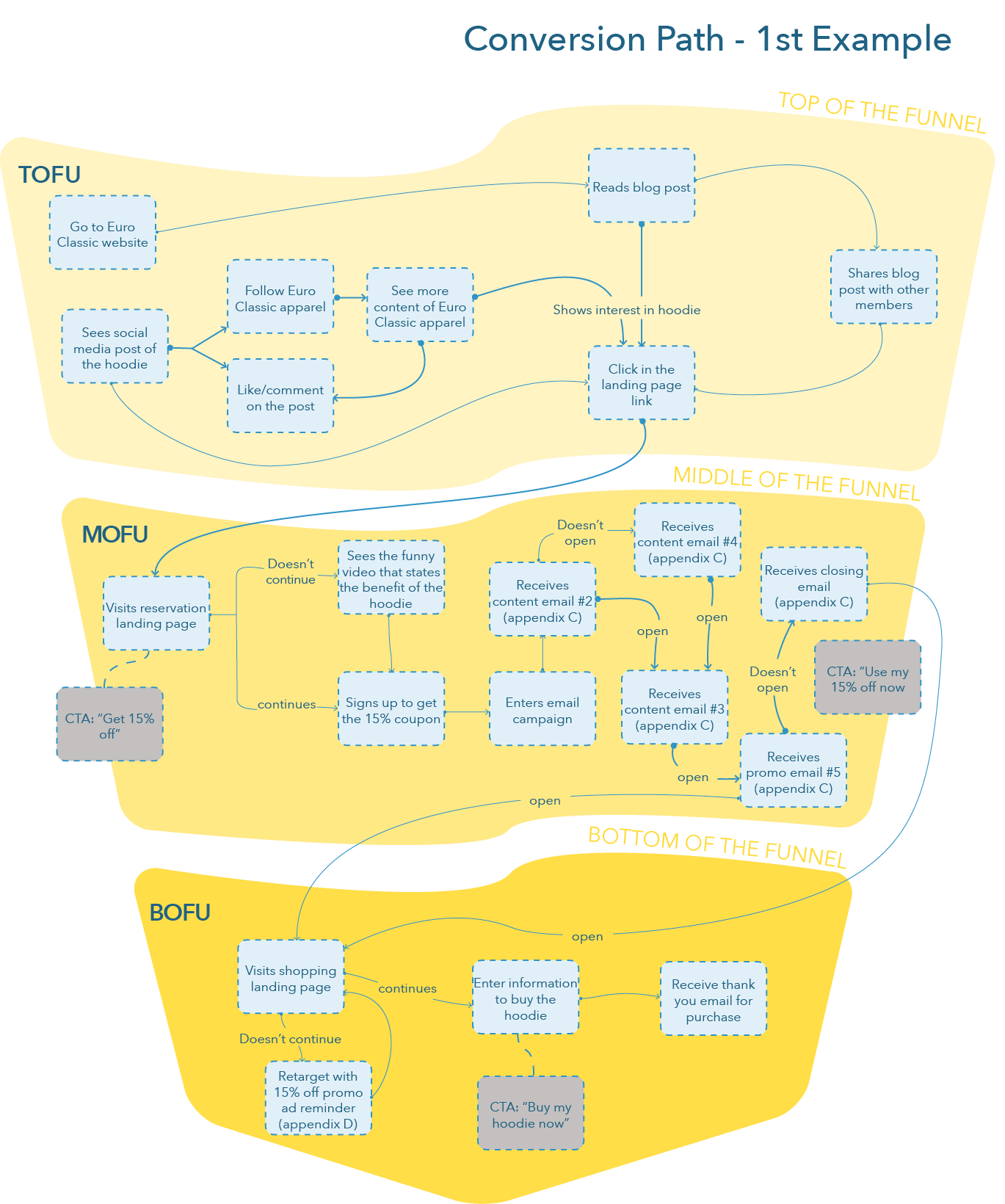
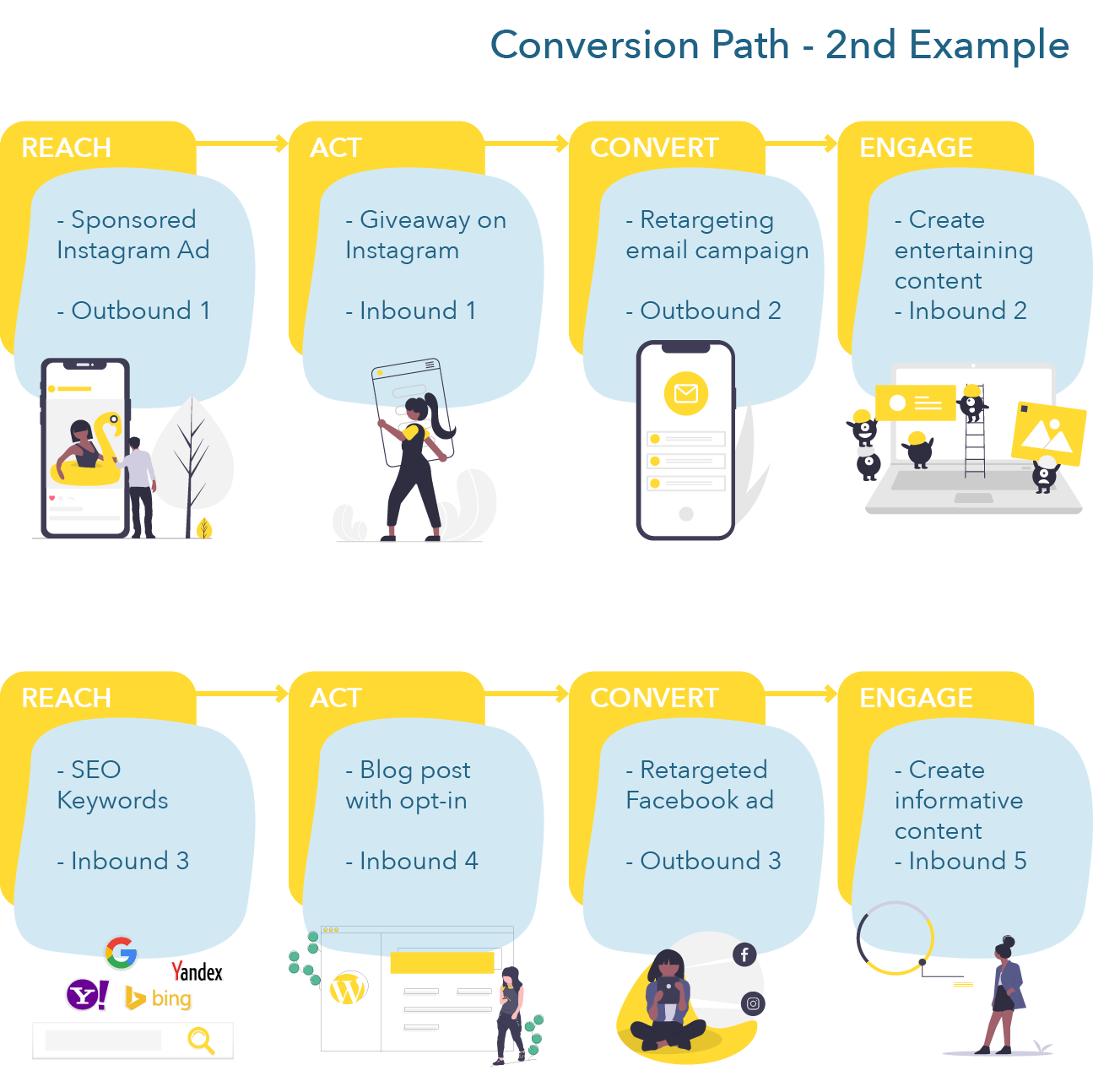
RACE for Competitive Analysis
The RACE framework (Figure 4.9; text description) is highly useful in creating a strategy for digital marketing campaigns. It helps answers questions such as the following:
- Reach: How do I bring visitors to my website?
- Act: How do I create a positive user experience? How do I transform visitors into leads?
- Convert: How do I convert leads into customers?
- Engage: Once I have customers, how do I ensure repeat purchases? How can I leverage my customers to participate in my marketing campaigns?
The strategic value of the RACE framework also makes it a great tool to guide competitive analysis. You can turn these questions around to better understand the digital marketing strategy of your competitors:
- Reach: How is my competition bringing visitors to their site?
- Act: Once they have visitors on their web properties, how does do they create positive interactions? How do they transform visitors into leads?
- Convert: How do they convert leads into customers?
- Engage: How do they ensure repeat purchases? How do they foster word-of-mouth and other co-creation activities?
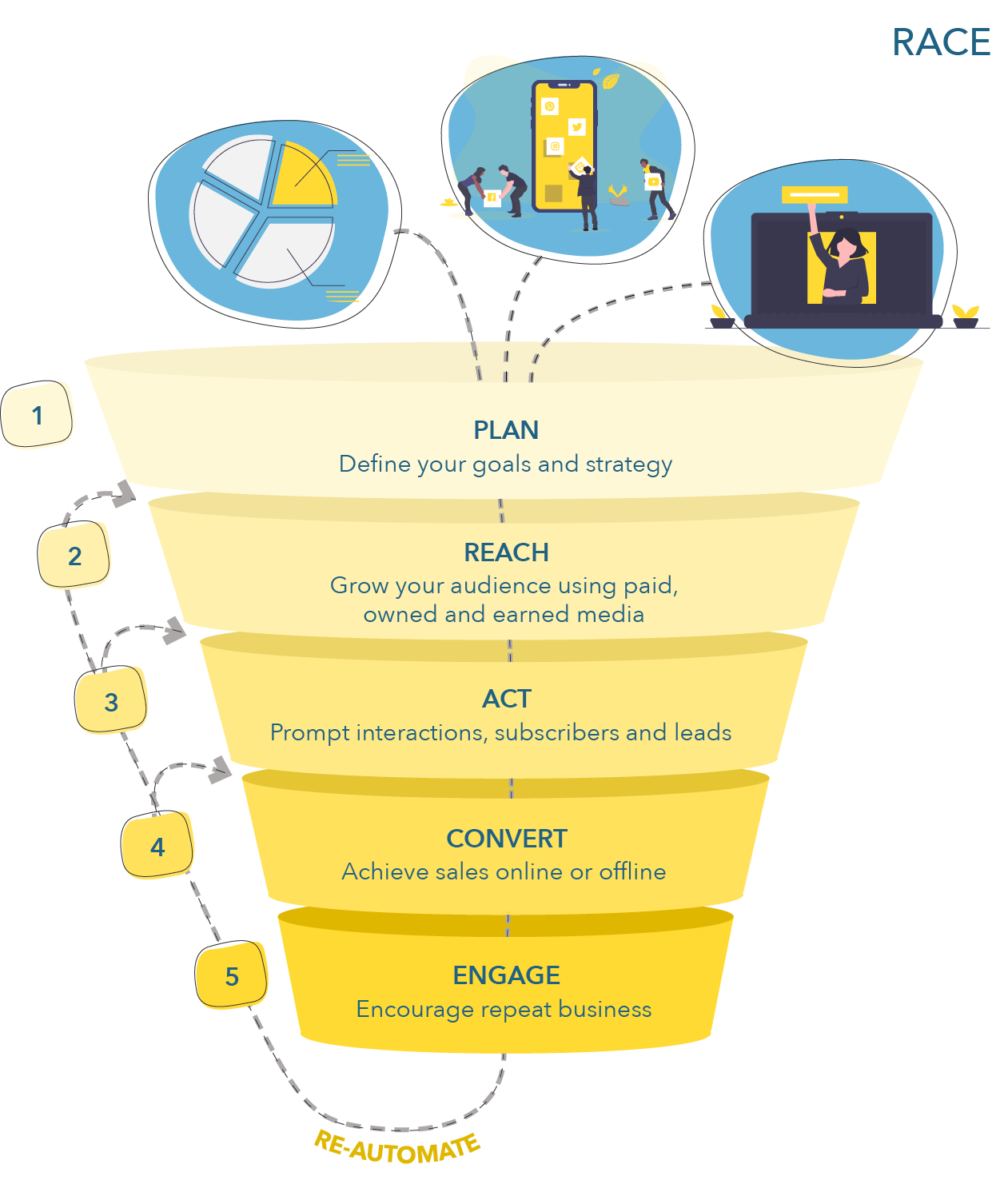
Reach
Understanding how your competitors bring in visitors can be of great use in crafting your own strategy for attracting people to your web properties. Questions to ask include
- How frequently are your competitors running promotions? What benefits do those promotions provide to their customers and potential shoppers, as well as their business?
- Are they running contests online? What kind?
- How are they using their social media channels? How do they drive people from their social media channels to their website?
- What information is included in their marketing banners and callouts?
Act
Similarly, an analysis of your competition should include a better understanding of the user experience on their website. For this stage, you can answer questions such as
- How are they creating positive interactions on their properties and transforming visitors into leads?
- Where are their calls to action throughout the browsing experience? What are the calls to action about?
- Do they have a blog? How frequently do they post? What type of information do they tackle?
- What is the role of content on their website? How does their content differ from yours?
Convert
The next stage is to better understand how your competition converts their leads into customers. To understand this, it is important to take the same steps a customer would: Register for your competitors’ newsletters, understand what happens once a cart is abandoned, and analyze persuasion attempts within webpages. To assist you, questions you should be able to answer include:
- How do they display their products and communicate details?
- How detailed are their product descriptions? What information do they include? What information is missing?
- Where are their calls to action throughout the browsing experience? What are those calls to action about?
- What happens in newsletters? Is there a clear, planned path created to maximize sales? What is that path?
- Do they have an abandoned-cart saver feature? If so, at what point do they send the emails and what are the messages in those emails?
- Is your competition retargeting visitors? Based on what variables?
Engage
To conclude your competitive analysis, become a customer of your competitors! Understand what happens once you buy a product. See whether there exist forums for your competitors’ brands, services, or products. How are consumers of your competitors interacting online? What are your competitors doing to foster such interactions? Here, you can ask
- What happened once you bought a product?
- Do your competitors have some sort of a club? Membership program? Online forum?
- Do they request reviews? Are there consumer-generated content (CGC) campaigns?
- Do they have consumer appreciation campaigns?
- Does their content always talk only to new consumers, or to existing ones as well?
Bringing Competitor Analysis Together
A great approach to try to better understand your competitors is to approach them as you would if you were a persona-related consumer going through the motions of their journey. This is a different logic from evaluating your competition based on other strategic frameworks, such as SWOT. SWOT, indeed, can be used to understand the strengths and weaknesses of your competition as it relates to their digital marketing resources. But never before were we able to analyze exactly how our competitors are operating. Because everything is archived online, and because you can readily have access to marketing efforts such as ads and content, understanding your competitors’ strategic efforts has perhaps never been more accessible. To conclude, to gather as much (targeted) information as possible, be sure to
- subscribe to their newsletter/blog,
- follow them on social media,
- purchase a product, paying attention to packaging, buying experience, and shipping time,
- put an item in your cart and abandon the checkout process,
- check their reviews,
- hunt for their ads,
- follow their publicity, and
- understand their backlinks.
Exercises
You are a fitness center creating a campaign for people who want to get back into shape.
One of the personas you are targeting is Avery.
Avery is a person living in a major Canadian city center. They are their late twenties to early thirties and are in the top 20% in revenue in their city. With increased responsibilities at work and a newborn, Avery had put exercising aside for a few years. They feel sluggish, lack energy, and miss having a stronger connection with their body. With age, their body has also started to transform, and they have started to feel self-conscious about it. To remediate this, they want to get back into exercising weekly. They don’t have much time, and they also don’t know much about working out or the market—for example, where to work out or how to work out.
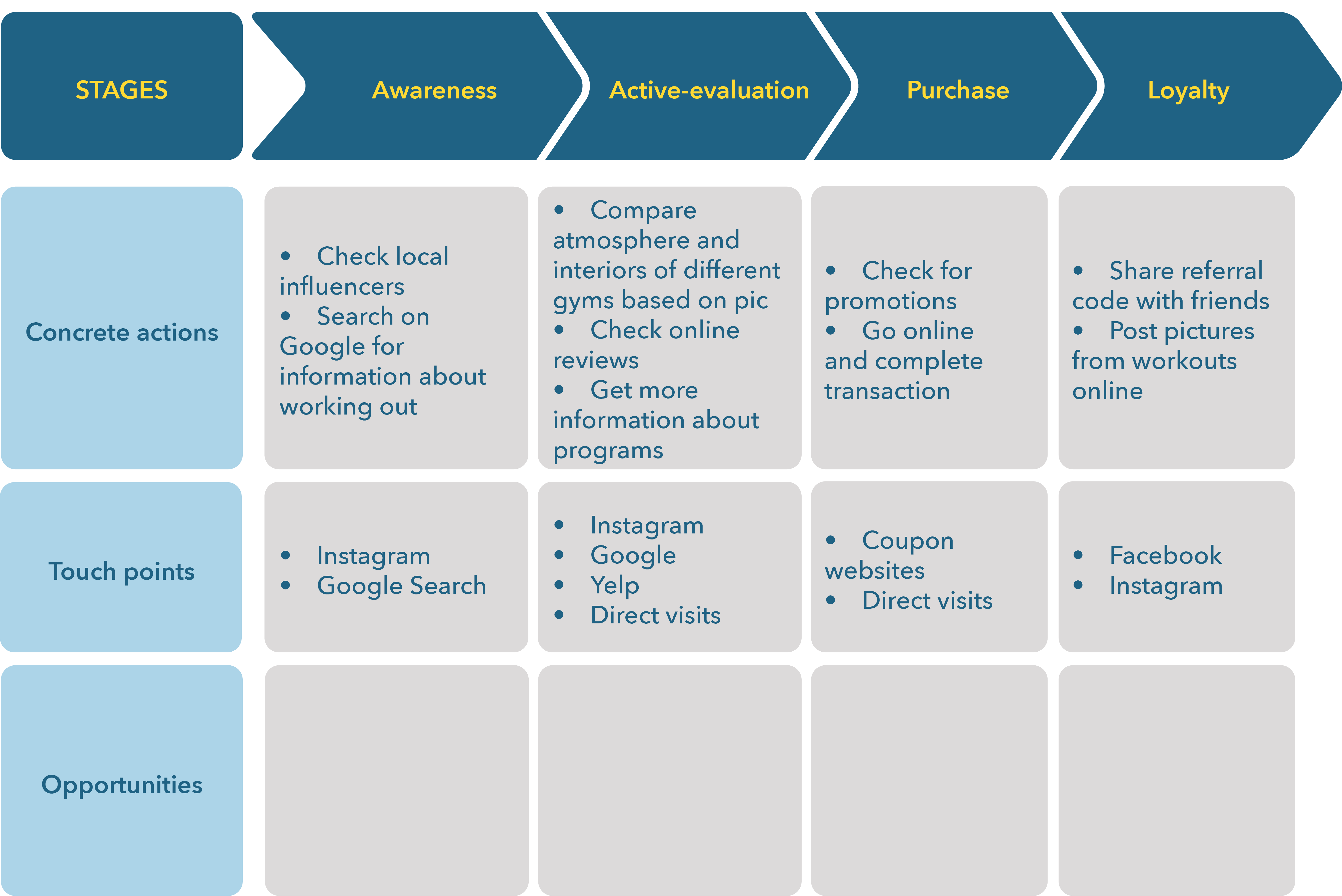
Social Media Analysis Using RACE
- @achievefitnessboston
- @lifetime.life
- @goodlifefitness
Think of the implications for generating awareness, attracting visitors, creating leads, converting leads into customers, and generating engagement.
Create a (Digital) Journey Map
Integrate paid, owned, and earned marketing activities for a campaign for your fitness center based on the journey map provided.
For one or two stages, accomplish the following actions:
- Start with the concrete actions of consumers.
- Identify opportunities.
- Translate the opportunities into concrete marketing activities.
- Find a way to make each activity a paid, owned, and earned media activity.

